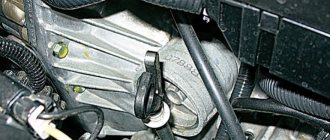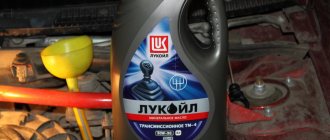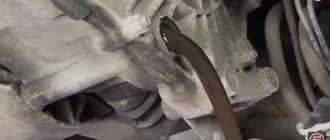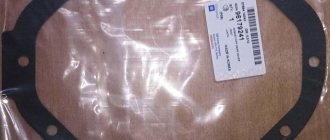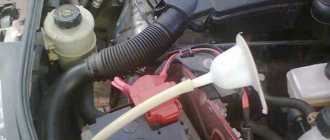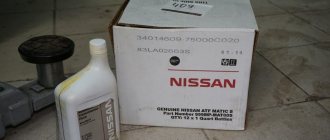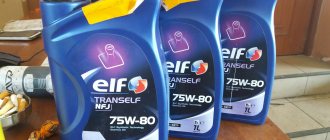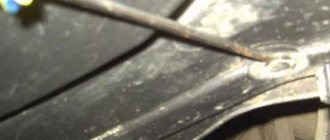Checking the level and changing the oil in a manual transmission Daewoo Nexia N150
Tools:
Parts and consumables:
Notes:
Check and, if necessary, replenish the oil level in the gearbox every 10 thousand kilometers or 6 months. operation.
Check the oil level in the gearbox no earlier than two minutes after stopping the engine. Carry out the work on an inspection ditch or overpass.
Checking the gearbox oil level
1. Using a 13 mm spanner, unscrew the inspection hole plug located next to the inner joint of the right wheel drive in the gearbox housing and remove it.
2. Insert your finger into the hole and check the oil level.
Note:
The normal oil level is at the bottom edge of the hole.
3. If there is insufficient oil, remove the breather cap.
4. Unscrew the breather with a 17 mm wrench and remove it from the hole in the gearbox housing.
5. Clean the metal trap of the transmission inspection plug.
6. Use a syringe to add oil to the Nexia gearbox to the bottom edge of the inspection hole (see point 2). As soon as the oil starts to come out through the inspection hole
7. Tighten the breather and inspection hole plug.
Changing the oil in the Nexia gearbox
Note:
The Daewoo Nexia N150 gearbox is filled with oil for its entire service life. Only the instructions are silent about the length of the period, so presumably it is 100-150 thousand km, or 7-10 years of operation. In any case, even on a new car, it is recommended to replace the mineral water poured into the box with synthetic water.
Even during the operation of the car, it may be necessary to drain the oil and replace it, for example, when repairing a gearbox or when there is a significant oil leak from the gearbox, when it is not possible to add oil of the same brand that was poured into the gearbox. It is recommended to change the oil when the gearbox is warm.
1. Clean the bottom cover of the gearbox from dirt. Place a wide container with a capacity of at least 3.5 liters under the lid.
2. Using a 13 mm socket, unscrew the ten bolts securing the cover partly and drain the oil into a substitute container.
3. After draining the oil, completely unscrew the bolts and remove the cover. Clean it from deposits, wear products of gearbox parts and traces of the old gasket, and also clean the mating surface of the gearbox housing.
4. Then put the gear in neutral, chock the rear wheels, apply the parking brake and jack up the front left wheel to drain any remaining oil from the 5th gear housing.
Note:
You need to jack it high (to the height of the jack, maybe even more). Rotate the left front wheel backwards, and more old oil will spill out.
In this way, approximately 1.7 liters are drained, with a total volume of oil poured into the gearbox of 1.8 liters.
5. Lower the car.
6. Replace the transmission cover gasket with a new one.
7. Screw in the bolts and tighten them evenly to the specified torque.
8. Fill the transmission oil into the gearbox to the required level, as described in the first part of the article.
The article is missing:
Source
12.6. Checking the fluid level in the 4T40-E transmission
Checking the transmission fluid level
| EXECUTION ORDER |
| 1. Place the car on a lift or inspection pit. The vehicle must be level for the fluid level check to be correct. |
| 2. Place a suitable container under the hole plug to check the fluid level. |
| 3. Start the engine and let it idle for about 5 minutes. If possible, you can also warm up the transmission by driving the car for several kilometers. |
| 4. With the brake pedal pressed, move the gearbox range selector through all positions sequentially, pausing in each position for several seconds. Then return the selector to position P (Parking). |
| 5. Unscrew the inspection hole plug. The normal level of the working fluid can be either above or below the edge of the control hole. In the first case, liquid will flow out of the control hole. Warning Hot fluid leaking from the inspection hole may cause burns. If fluid leaks from the inspection hole, the transmission may be overfilled. After the fluid flow from the hole has stopped, the level of the working fluid in the crankcase will be normal. Replace the plug and tighten it to 12 Nm. If fluid does not flow out of the open inspection hole, the transmission fluid level may be too low. In this case, you should pour the working fluid into the crankcase through the filler hole in small portions (0.5 liters each) until it starts flowing out of the control hole, but in total no more than 1.5 liters. If at the same time liquid began to flow out of the control hole, its level was normal. Allow excess fluid to completely drain from the inspection hole and replace the plug. Tighten the inspection hole plug to 12 Nm. If, after adding one and a half liters, the level of the working fluid did not rise to the lower edge of the control hole (the liquid does not flow out of the control hole), this indicates that the level of the working fluid in the transmission was below normal. Leaks of working fluid are also possible. It is necessary to inspect the transmission for signs of leaks and eliminate any detected faults before bringing the fluid level to normal. |
| 6. After checking the fluid level, wipe away any traces of leaks on the surface of the transmission housing with a rag. Check that the filler cap and vent tube are installed correctly. |
Adding fluid to normal level after transmission repair
| EXECUTION ORDER |
| 1. Depending on the type of repair, the following amount of working fluid should be poured into the transmission charter. Repairs associated with dismantling the transmission sump (without removing the transmission from the vehicle) – 7 l. Replacing the torque converter - 2.5 liters. Repairs associated with complete disassembly of the transmission - 10 liters. |
| 2. Perform operations one through four to check the working fluid level. |
| 3. Pour working fluid into the crankcase through the filler hole in large portions (0.5 liters each) until it begins to flow out of the control hole. |
| 4. Allow excess fluid to completely drain from the inspection hole and replace the plug. Tighten the inspection hole plug to 12 Nm. |
| 5. After bringing the working fluid level to normal, wipe away any traces of leakage on the surface of the transmission housing with a rag. Check that the filler cap and vent tube are installed correctly. |
Replacement frequency
The manufacturer claims that oil is poured into the Daewoo Nexia gearbox for the entire period of operation of the car, but does not specify exactly how long this service life should be and how to check whether it has expired or not. Therefore, in order to avoid serious financial costs for gearbox repairs, it is recommended to change the gearbox oil every 100 thousand km. mileage If you have difficulty shifting gears in cold weather, you can change the oil in the box even before the mileage reaches 100 thousand.
How much should I fill?
It is equally important for owners of these car models to know how many liters are poured into the transmission. Service books for cars that require replacement of this consumable usually contain a table with fill parameters. In the case of an 8- or 16-valve Nexia, there is no such information in the service manual. However, before changing, you need to consider how much lubricant to pour into the gearbox.
As for volume, the transmission of the Daewoo Nexia should contain about 1.8 liters of oil.
| Engine | L.S. | Years of manufacture | Oil volume in manual transmission | Automatic transmission oil volume |
| 1,5 | 75 | 1995-2008 | 1.8 l | 3.5 l |
| 1.5i 16V DOHC | 85/90 | 2002-2008 | 1.8 l | 3.5 l |
| 1,6 | 109 | 2008 | 2 l | 3.5 l |
Getting ready for replacement
The motor lubricant in the Daewoo Nexia engine, regardless of how many valves it has, needs to be changed every 10,000 kilometers, but in our conditions this period should be halved, that is, after 5,000 kilometers. Also, when changing engine lubrication, it will not be superfluous to replace the oil filter, regardless of how many valves there are in the engine.
How much oil to pour?
On average, a replacement will require about 3.75 liters of oil for an 8-valve and 16-valve power unit. In a word, buy a four-liter canister at the store.
What kind of oil should I use?
The choice of lubricant brand is individual, there are no restrictions, and it is better to give preference to brands with a better reputation, but the oil must meet the following conditions:
Domestic oils can also be used if they meet the required specifications.
Useful tips
It is almost impossible to check what exactly is poured into the gearbox at the factory, but most often this oil turns out to be mineral oil, which thickens quite strongly in winter. When planning a replacement, it is recommended to purchase synthetic or semi-synthetic gearbox oil.
From time to time, at least once every 15 thousand km. mileage, you should check the lubricant level in the gearbox. The design of the Daewoo Nexia gearbox does not provide for lubricant replacement throughout its entire service life. However, sometimes the need for replacement still arises - in the case of a gearbox repair, when switching to a lubricant with a different viscosity, and in other similar situations. When planning a replacement, it is advisable to drain the old lubricant in a warm and fluid state, that is, within 10-15 minutes from the end of the trip.
Checking the gearbox oil level
Before you begin inspection, you need to place the vehicle on a level surface. Parking on a slope will significantly distort the parameters and lead to a violation of the operating mode.
In the cold
Used when the vehicle design does not provide otherwise. Most often this happens on manual transmissions. In winter, when there is severe frost, the readings are distorted, so it is better to use a heated garage or a warm box for inspection.
Much depends on the quality of the transmission fluid. Low-grade ones significantly change their viscosity when frozen. High-quality ones, for example, Hessol, maintain indicators within the established criteria and make it possible to perform testing in natural conditions.
Hot
The method is accurate. The lubricant occupies the working position and is evenly distributed over the rubbing surfaces of bearings and gears, covers the shafts and protects them from rapid abrasion.
You can find out the oil level in the gearbox in this way, both manually and automatically. In the latter case, this is the most common option.
Due to high temperatures, inspection using a test plug is not possible. If you do not have a dipstick on your vehicle, then the test is carried out cold or using sensors of electronic systems with subsequent output to the dashboard.
According to the control plug
Quite an outdated technique. Mainly used on trucks or cars with manual gear shift. Due to the fact that there are no bright yellow and orange labels on the case, this method causes the most misunderstanding. Most people have a question about how and where to check the oil level in the gearbox. You can do this using this quick guide:
Which one should I use?
Accordingly, the Daewoo Nexia gearbox can be filled with both mineral oil 80W90 GL-4 and synthetic or semi-synthetic oil 75W80, 75W90, 80W85 GL-4. One of the best options can be considered 80W GL-4. Synthetic lubricant 75W80 is also excellent, especially in winter. In summer, this oil leads to noise in the gearbox, so it is still better to use oils recommended by the manufacturer.
The volume of oil that must be poured into the gearbox is 1.8 liters.
Gear oil for gearbox LIQUI MOLLY (SAE 80W GL-4)
Which oil is better to choose?
When changing the oil in a Daewoo Nexia n150 gearbox with 8 or 16 valves, you need to know what kind of lubricant should be poured into the system. The manufacturer does not regulate this replacement. Accordingly, you will not be able to find information about choosing a product in the service book. Practice shows that Daewoo Nexia gearboxes whose owners fill with synthetic or semi-synthetic lubricant last a long time. Initially, when a car is manufactured, mineral oil is used in the gearbox, so when buying a car it is also better to change it to “synthetic” or “semi-synthetic”.
If the climate in your region is moderate, then you can safely use any oil of the SAE 80W GL-4 standard. When operating a car in severe frost conditions, it is better to give preference to the 75W90 GL-4, proven by car enthusiasts. This lubricant is especially suitable for northern regions, where the average air temperature throughout the year is -25 degrees. It is possible to use both synthetic and semi-synthetic oils, but for cold climates “synthetics” are better suited. The use of such fluid in the warm season can lead to noise in the transmission.
Transmission fluid MANNOL Hypoid Getriebeoel 80W-90 API
Tools
In order to replace the fluid in the gearbox of a Daewoo Nexia, you will need the following tools and accessories:
In order to choose the right gasket, it is first recommended to inspect the transmission pan from below. This is due to the fact that there are two types of pallets, having 10 or 11 holes - the number of holes must be checked before purchasing a gasket. In addition, you don’t have to buy a gasket, but remove the pan and cut it out yourself from paronite, or simply replace it with a sealant, which in practice copes well with the task.
How to change the lubricant yourself?
You can replace the working fluid with the help of specialists at a service station or yourself. Let's look at the process of changing it yourself.
Preparation
Before completing a task, you need to prepare. Buy two liters of lubricant and prepare the tools:
- a set of wrenches or socket heads (you will need tools for 13, 17 and 19);
- jack;
- medical or construction syringe;
- new transmission pan gasket;
- an old bucket, basin or cut-off bottle for collecting waste.
Before purchasing a gasket, be sure to inspect the pan on the transmission. On sale you can find two types of pallet gaskets, which are mounted with 10 or 11 bolts. Therefore, when buying a seal, make sure that it suits you. If it is not possible to purchase a gasket, you can make it yourself from paronite. As a last resort, if there is no seal, the perimeter of the pan must be coated with sealant.
Replacing engine fluid
First, check that the Daewoo Nexia is parked on a level surface. Replacement in the engine is carried out in a pit or overpass. If this does not work, then we jack up the car, observing safety precautions.
What tools should you have on hand?
Replacing daewoo nexia engine fluid - process
Take a look at the light bulb that monitors your blood pressure. If it goes out 20 seconds after turning it on, then everything is fine. If not, then turn off the engine and find out the cause of the problem. Also check the oil level. If the permissible value is exceeded, then drain the excess. If it is lower, add more. Inspect the car and the area underneath it. Check that nothing is leaking anywhere. Take a closer look at the lubricant used. The color should be uniform. If sand or chips are present, sound the alarm, as these are the very first signs of engine trouble.
The process of changing the lubricant in a light car engine
There should be no rings from the cooled liquid on the base of the used motor fluid. The composition should be viscous and thick. It is important to properly dispose of used liquid. If there is a stain in the area where the repair was carried out, be sure to use sand.
Daewoo Nexia engine lubrication has its own characteristics. It is necessary to check the dipstick in the engine when the vehicle is parked on a level surface. When turning on the engine, turn it off and wait 5 minutes before checking. Such a pause is necessary so that the liquid gets into the daewoo nexia engine crankcase.
Regular contact of exposed areas of the body with used lubricant contributes to various skin diseases: dermatitis, skin tumors. Avoid additional contact with liquid and wash your hands thoroughly after the event.
Checking the fluid level in the 4T40-E Daewoo Nexia transmission
General information Monitoring the transmission fluid level
| General information |
| 1. Place the car on a lift or inspection pit. The vehicle must be level for the fluid level check to be correct. |
| 2. Place a suitable container under the hole plug to check the fluid level. |
| 3. Start the engine and let it idle for about 5 minutes. If possible, you can also warm up the transmission by driving the car for several kilometers. |
| 4. With the brake pedal pressed, move the gearbox range selector through all positions sequentially, pausing in each position for several seconds. Then return the selector to position P (Parking). |
| 5. Unscrew the inspection hole plug. The normal level of the working fluid can be either above or below the edge of the control hole. In the first case, liquid will flow out of the control hole. Warning Hot fluid leaking from the inspection hole may cause burns. If fluid leaks from the inspection hole, the transmission may be overfilled. After the fluid flow from the hole has stopped, the level of the working fluid in the crankcase will be normal. Replace the plug and tighten it to 12 Nm. If fluid does not flow out of the open inspection hole, the transmission fluid level may be too low. In this case, you should pour the working fluid into the crankcase through the filler hole in small portions (0.5 liters each) until it starts flowing out of the control hole, but in total no more than 1.5 liters. If at the same time liquid began to flow out of the control hole, its level was normal. Allow excess fluid to completely drain from the inspection hole and replace the plug. Tighten the inspection hole plug to 12 Nm. If, after adding one and a half liters, the level of the working fluid did not rise to the lower edge of the control hole (the liquid does not flow out of the control hole), this indicates that the level of the working fluid in the transmission was below normal. Leaks of working fluid are also possible. It is necessary to inspect the transmission for signs of leaks and eliminate any detected faults before bringing the fluid level to normal. |
| 6. After checking the fluid level, wipe away any traces of leaks on the surface of the transmission housing with a rag. Check that the filler cap and vent tube are installed correctly. |
Adding fluid to normal level after transmission repair
| General information |
| 1. Depending on the type of repair, the following amount of working fluid should be poured into the transmission charter. Repairs associated with dismantling the transmission sump (without removing the transmission from the vehicle) – 7 l. Replacing the torque converter - 2.5 liters. Repairs associated with complete disassembly of the transmission - 10 liters. |
| 2. Perform operations one through four to check the working fluid level. |
| 3. Pour working fluid into the crankcase through the filler hole in large portions (0.5 liters each) until it begins to flow out of the control hole. |
| 4. Allow excess fluid to completely drain from the inspection hole and replace the plug. Tighten the inspection hole plug to 12 Nm. |
| 5. After bringing the working fluid level to normal, wipe away any traces of leakage on the surface of the transmission housing with a rag. Check that the filler cap and vent tube are installed correctly. |
How to correctly check the volume and level of oil in a gearbox (gearbox)
There are no difficulties in the process, but there are a number of methods that radically distinguish the inspection:
The temperature at which you perform the service can have a critical impact. The measurement indicators will differ radically. When the vehicle is warm, the contents of the gearbox from the pan spread over all components, bearings and gears. Significantly less petroleum products remain below. When cooling, on the contrary, the operating fluid tends downwards and increases the filling level.
Modern machine devices make it possible to check the oil level in two ways, but when it’s hot, the readings will be much more accurate. In cold weather without warming up, it is not recommended to carry out control at all. Data may be greatly distorted. At subzero temperatures, transmission lubricant quickly thickens and a significant amount of it remains on the walls and parts without ever getting into the crankcase.
The technology should be clarified according to the service book or operating instructions. There is a universal way to do this without resorting to additional reference books. Remove the dipstick from the gearbox housing and inspect it carefully. There are several options for displaying the level:
If you need to track oil products in the crankcase on a warm unit, it is not enough to start the engine and let it run. The gears remain stationary. You need to drive the car, or switch the handle to all positions in place if we are talking about an automatic machine.
Source
How to change the oil in a Daewoo Nexia gearbox yourself
If you are the owner of a Daewoo Nexia car, you may encounter a problem such as a lack of technical information regarding the frequency of oil changes in the Daewoo Nexia gearbox.
Indeed, in the instructions, the manufacturer clearly indicates that the volume of transmission fluid will ensure correct operation of the gearbox throughout its entire operating life. Unfortunately, even if you try to re-read these lines several times, you still won’t find a word about when this operational period ends.
We will try to help you in this matter by providing useful information to increase your knowledge regarding the operation of individual important components and mechanisms of your car.
The oil change in the Daewoo Nexia gearbox should be carried out after 60 - 100 thousand kilometers.
Change of oil
Some motorists prefer to perform such manipulations almost immediately after purchasing a car, despite the extremely low mileage. They argue for their actions by the fact that oil could have been filled at the factory, accompanied by technical characteristics that do not suit the car owner.
How many liters of oil should be poured into the Daewoo Gentra 1.5 engine
Daewoo Gentra is a compact four-door sedan made in Uzbekistan, produced since 2013. This model was considered the most affordable foreign car in Russia among its competitors. Gentra is a copy of the Korean Chevrolet Lacetti sedan from 2002, but has a more interesting design in the front part of the body, like the Lacetti hatchback. In Russian car dealerships, the Gentra was offered with a single 1.5-liter engine (107 hp) and a manual transmission, the alternative to which was a six-speed automatic transmission. In the basic configuration, the car had two airbags, air conditioning, electric mirrors and windows, and additional options included an audio system, heated front row seats and a sunroof. In 2016, the car was renamed Ravon Gentra. Sales in Russia continued until 2022, then deliveries were stopped indefinitely.
Regulations for changing oil in internal combustion engines
Experienced motorists and experts recommend changing the oil in the Daewoo Gentra engine every 10-15 thousand km. If necessary, the regulations can be adjusted depending on the conditions in which the car is operated. But an oil change is necessary in any case, otherwise there is a risk of the following problems:
- The oil loses its beneficial properties and is no longer relevant. Since then, it has done more harm than good. The load on the moving components of the internal combustion engine increases, the behavior of the car changes for the worse, and scuffing appears in the cylinder-piston group, compression drops, etc. As a result of a major engine overhaul, engine overhaul cannot be avoided.
- Lack of heat removal, lack of cooling, overheating and other negative factors that force the engine to work in difficult conditions cause accelerated wear of internal combustion engine components and its further failure.
- The protective and lubricating properties of the oil are no longer relevant, since it is outdated and accumulates sediment, dirt deposits and wear products. All this gradually accumulates and spreads through the engine channels, which leads to the development of corrosion processes.
Changing the oil in the Daewoo Nexia gearbox
The manufacturer claims that oil is poured into the Daewoo Nexia gearbox for the entire period of operation of the car, but does not specify exactly how long this service life should be and how to check whether it has expired or not. Therefore, in order to avoid serious financial costs for gearbox repairs, it is recommended to change the gearbox oil every 100 thousand km. mileage If you have difficulty shifting gears in cold weather, you can change the oil in the box even before the mileage reaches 100 thousand.
Which one should I use?
Accordingly, the Daewoo Nexia gearbox can be filled with both mineral oil 80W90 GL-4 and synthetic or semi-synthetic oil 75W80, 75W90, 80W85 GL-4. One of the best options can be considered 80W GL-4. Synthetic lubricant 75W80 is also excellent, especially in winter. In summer, this oil leads to noise in the gearbox, so it is still better to use oils recommended by the manufacturer.
The volume of oil that must be poured into the gearbox is 1.8 liters.
Gear oil for gearbox LIQUI MOLLY (SAE 80W GL-4)
Tools
In order to replace the fluid in the gearbox of a Daewoo Nexia, you will need the following tools and accessories:
In order to choose the right gasket, it is first recommended to inspect the transmission pan from below. This is due to the fact that there are two types of pallets, having 10 or 11 holes - the number of holes must be checked before purchasing a gasket. In addition, you don’t have to buy a gasket, but remove the pan and cut it out yourself from paronite, or simply replace it with a sealant, which in practice copes well with the task.
Instructions
Changing the oil in the gearbox is carried out on an overpass or pit. The replacement procedure includes the following steps.
1-3 steps 4-7 steps 8 step 9-11 steps
At this point, replacing the fluid in the Daewoo Nexia gearbox can be considered complete. There is nothing complicated about this, all that remains is to check and make sure that the gears change easily enough, regardless of the time of year.
instructions from TANTOA
If you have any questions, or you couldn’t understand the text instructions, we suggest watching our video.
Did you carry out the replacement yourself?
How many liters of oil should be poured into the 1.5, 1.6 Daewoo Nexia engine
Daewoo Nexia is a very popular car on the secondary market. The machine is structurally simple and understandable, and does not require large expenses for independent maintenance. And as a result, more and more Daewoo Nexia owners are ready to repair their car at home. At the same time, Nexia owners have many questions about the frequency of engine oil changes, as well as what parameters are best to use when choosing a fluid. Also in this article we will consider separately how much oil should be poured into the Daewoo Nexia engine.
Regulations
Russian owners of Daewoo Nexia have long not paid attention to the manufacturer's recommendations regarding the frequency of oil changes, and proceed mainly from practical considerations. We must immediately admit that under Russian operating conditions the oil change regulations cannot be the same. Negative climatic factors make themselves felt over time, and this cannot have a positive effect on the service life of the oil, and at the same time the durability of the power plant. Firstly, initially we must base the replacement period on 10 thousand kilometers, and then the frequency can be reduced if the need arises
Secondly, let’s pay attention to unfavorable operating conditions:
- Frequent driving on bad roads, including off-road, dusty country roads, muddy ground, etc.
- Driving at high speeds
- The engine constantly runs at high speeds, overheating occurs
- Changes in temperature and climate: rain gives way to snow, and low temperatures give way to a sudden thaw
Any of the above factors may cause you to change your oil more frequently. In such cases, it is better to replace consumables after 5 thousand kilometers, or even earlier. In addition, it would be a good idea to check the level and condition of the fluid in a timely manner.
Checking the oil level and condition
To correctly determine the amount of liquid remaining, you need to use a dipstick. There are Max and Min marks on it, by which you can understand the oil level. For example, if the fluid is below the minimum level (Min), then topping up will be necessary. In this case, it is better not to overflow, otherwise you will have to drain the oil later. The optimal oil level is between Max and Min.
It is worth noting the fact that just adding oil will be enough if the oil is relatively clean and transparent. If the fluid becomes cloudy and darkened, or emits a specific odor and even contains dirt deposits, then immediate replacement will be required.
How much to fill
Let's consider how much oil to fill for each Daewoo Nexia engine:
Engine – petrol, 1.6 16V 100+ hp. With.
- How much to fill – 4 liters
- Year of manufacture – since 2008
The volume of oil is indicated in the amount that needs to be filled after a comprehensive flushing of the engine from old fluid. In other words, the specified volume cannot be maintained if only a partial oil change has been carried out. Naturally, this method of topping up is not suitable. A complete flush can also be done in a garage, but to do this you will have to drain and fill in new oil several times, with intervals of 500-700 kilometers. Continue until fresh clear liquid begins to seep out of the engine during draining. By ensuring complete cleaning, you can be sure that new oil will be added in the required quantity.
Choosing oil for Daewoo Nexia
For a given car, when choosing an oil, you must proceed from certain viscosity characteristics: 5W-30, 5W-40 or 10W-40. For example, you may prefer the following products:
- Shell Helix HX8 5W-40
- ZIK 5W-30
- Mobile 10W-40
- Eneos 5W-40.
maslospec.ru
How to change the oil in a Daewoo Sens gearbox. Level check
Daewoo Sens cars with MeMZ 307 and MeMZ 317 1.3 and 1.4 liter engines are equipped with a domestic Melitopol gearbox. It proved to be quite reliable and unpretentious, but sensitive to the oil level.
It has been noticed that if you use cheap oils and do not monitor the level, the box begins to howl. Second or third gear may also be difficult to engage for the same reason. To extend the service life of the gearbox, it is necessary to monitor the oil level and change it regularly.
How much oil is in the Daewoo Sens gearbox, when to change it
The Sens gearbox is identical in design to the unit that was installed on Tavria and Slavuta, so you can’t expect any tricks from it. The fundamental differences between the boxes are only in the gear ratios and gear shift mechanism. The latter is completely taken from the senior Lanos.
The factory capacity of the gearbox, regardless of engine size, is 2.45 liters.
This volume corresponds to the geometric center of the inner CV joint oil seal hole and the lower edge of the control filler hole.
An oil change is carried out at a mileage of no more than 30,000 km, and it is advisable to check the level every 10,000 miles. In addition, it is necessary to pay attention to the condition of the drive seals. At the first signs of drips in the area of the axle shafts, the seals are replaced with new ones.
In addition, the gearbox input shaft oil seal may leak; drips in the lower part of the crankcase will tell you about this, but it leaks extremely rarely and can easily withstand more than 150 thousand mileage.
11.6. Checking the fluid level in the 4T40-E transmission
| GENERAL INFORMATION |
Checking the transmission fluid level
| EXECUTION ORDER |
| 1. Place the car on a lift or inspection pit. The vehicle must be level for the fluid level check to be correct. 2. Place a suitable container under the hole plug to check the fluid level. 3. Start the engine and let it idle for about 5 minutes. If possible, you can also warm up the transmission by driving the car for several kilometers. 4. With the brake pedal pressed, move the gearbox range selector through all positions sequentially, pausing in each position for several seconds. Then return the selector to position P (Parking). 6. After checking the fluid level, wipe away any traces of leaks on the surface of the transmission housing with a rag. If fluid leaks from the inspection hole, the transmission may be overfilled. After the fluid flow from the hole has stopped, the level of the working fluid in the crankcase will be normal. Replace the plug and tighten it to 12 Nm. If fluid does not flow out of the open inspection hole, the transmission fluid level may be too low. In this case, you should pour the working fluid into the crankcase through the filler hole in small portions (0.5 liters each) until it starts flowing out of the control hole, but in total no more than 1.5 liters. If at the same time liquid began to flow out of the control hole, its level was normal. Allow excess fluid to completely drain from the inspection hole and replace the plug. Tighten the inspection hole plug to 12 Nm. If, after adding one and a half liters, the level of the working fluid did not rise to the lower edge of the control hole (the liquid does not flow out of the control hole), this indicates that the level of the working fluid in the transmission was below normal. Leaks of working fluid are also possible. It is necessary to inspect the transmission for signs of leaks and eliminate any detected faults before bringing the fluid level to normal. |
Adding fluid to normal level after transmission repair
| EXECUTION ORDER |
| 1. Depending on the type of repair, the following amount of working fluid should be poured into the transmission charter. Repairs associated with dismantling the transmission sump (without removing the transmission from the vehicle) – 7 l. Replacing the torque converter - 2.5 liters. Repairs associated with complete disassembly of the transmission - 10 liters. 2. Perform operations one through four to check the working fluid level. 3. Pour working fluid into the crankcase through the filler hole in large portions (0.5 liters each) until it begins to flow out of the control hole. 4. Allow excess fluid to completely drain from the inspection hole and replace the plug. Tighten the inspection hole plug to 12 Nm. 5. After bringing the working fluid level to normal, wipe away any traces of leakage on the surface of the transmission housing with a rag. Check that the filler cap and vent tube are installed correctly. |

